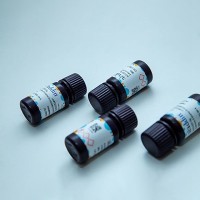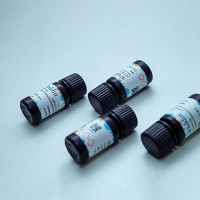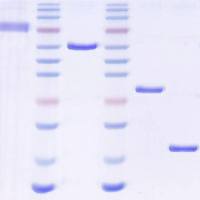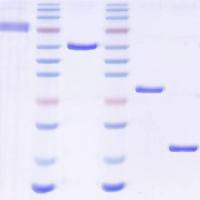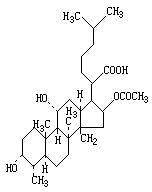Characterization of P1 (Adenosine) Purinoceptors
互联网
- Abstract
- Table of Contents
- Materials
- Figures
- Literature Cited
Abstract
The purine nucleoside adenosine (ADO) is an important modulator of cellular function in mammalian tissues, modulating cellular function and neuronal excitability via interactions with different cell surface receptor subtypes that are heterogeneously distributed in both the mammalian CNS and peripheral tissues. Four ADO receptor subtypes have been cloned and characterized. Described in this unit are three radioligand binding assays for pharmacological characterization of the high?affinity ADO receptor subtypes A1 , A2A , and A3 receptors. Pharmacological characterization of the low?affinity A2B receptor has been enabled by the use of tritiated xanthine PSB?603. Because receptor localization is an important criterion for differentiation of receptor subtypes, a support protocol that describes the methodology for the localization of ADO receptors in rat brain tissue using autoradiography is also included. Curr. Protoc. Pharmacol . 62:1.9.1?1.9.16. © 2013 by John Wiley & Sons, Inc.
Keywords: adenosine; G protein?coupled receptor; neuromodulation
Table of Contents
- Introduction
- Basic Protocol 1: Determination of [3H]CHA Binding to A1 Receptors
- Basic Protocol 2: Determination of [3H]CGS 21680 Binding to A2A Receptors
- Basic Protocol 3: Determination of [125I]AB‐MECA Binding to A3 Receptors
- Support Protocol 1: Autoradiographic Localization of ADO Receptor Subtypes
- Reagents and Solutions
- Commentary
- Literature Cited
- Figures
- Tables
Materials
Basic Protocol 1: Determination of [3H]CHA Binding to A1 Receptors
Materials
Table 1.9.2 MaterialsComparison of the Activity of Various Adenosine Agonists and Antagonists in Inhibiting Radioligand Binding to High‐Affinity Adenosine Receptor Subtypes
Basic Protocol 2: Determination of [3H]CGS 21680 Binding to A2A Receptors
Materials
Basic Protocol 3: Determination of [125I]AB‐MECA Binding to A3 Receptors
Materials
Support Protocol 1: Autoradiographic Localization of ADO Receptor Subtypes
Materials
|
Figures
-
Figure 1.9.1 (A ) Representative autoradiographic image of specific [3 H]CHA (1 nM) binding to rat brain sagittal sections (Jarvis, ). (B ) Representative autoradiographic image of specific [3 H]CGS 21680 (5 nM) binding to ADO A2A receptors in an adjacent rat brain sagittal section. Specific binding is revealed by digital subtraction autoradiography, in which the image of specific binding is obtained through subtraction of the linearized nonspecific binding image from the total binding image. Dark areas represent regions of densely bound radioligand, whereas lighter areas indicate little or no specific binding. Abbreviations: C, cerebral cortex; CP, caudate‐putamen; NA, nucleus acumbens; OT, olfactory tubercle; TH, thalamus; CA1 and CA3, CA1 and CA3 regions of hippocampus; CG, cerebellum, granular layer; CM, cerebellum, molecular layer. View Image
Videos
Literature Cited
| Borrmann, T., Hinz, S., Bertarelli, D.G.G., Li, W., Florin, N.C., Scheiff, A.B., and Müller, C.E. 2009. 1‐Alkyl‐8‐(piperazine‐1‐sulfonyl)phenylxanthines: Development and characterization of adenosine A2B receptor antagonists and a new radioligand with subnanomolar affinity and subtype specificity. J. Med. Chem. 52:3994‐4006. | |
| Bradford, M.M. 1976. A rapid and sensitive method for the quantitation of microgram quantities of protein utilizing the principle of protein‐dye binding. Anal. Biochem. 72:248‐254. | |
| Bruns, R.F., Lu, G.H., and Pugsley, T.A. 1986. Characterization of the A2 adenosine receptor labeled by [3H]NECA in rat striatal membranes. Mol. Pharmacol. 29:331‐346. | |
| Burnstock, G. and Verkhratsky, A. 2012. Purinergic signaling. WIREs Membr. Transp. Signal. 1:116‐125. | |
| Cunha, R.A., Johansson, B., Constantino, M.D., Sebastiao, A.M., and Fredholm, B.B. 1996. Evidence for high affinity binding sites for the adenosine agonist [3H]CGS 21680 in rat hippocampus and cerebral cortex that are different from striatal A2A receptors. Naunyn Schmiedebergs Arch. Pharmacol. 349:374‐380. | |
| Dulla, C.G. and Masino, S.A. 2013. Physiologic and metabolic regulation of adenosine: Mechanisms. In Adenosine. A Key Link between Metabolism and Brain Activity. (S. Masino and D. Boison, eds.) pp. 87‐107. Springer, New York. | |
| Eckle, T., Krahn, T., Grenz, A., Köhler, D., Mittelbronn, M., Ledent, C., Jacobson, M.A., Osswald, H., Thompson, L.F., Unertl, K., and Eltzschig, H.K. 2007. Cardioprotection by ecto‐5′‐nucleotidase (CD73) and A2B adenosine receptors. Circulation 115:1581‐1590. | |
| Emson, P.C. and Koob, G. 1978. The origin and distribution of dopamine‐containing afferents to the rat frontal cortex. Brain Res. 142:249‐267. | |
| Fredholm, B.B., IJzerman, A.P., Jacobson, K.A., Linden, J., and Müller, C.E. 2011. International Union of Basic and Clinical Pharmacology. LXXXI. Nomenclature and classification of adenosine receptors—An update. Pharmacol. Rev. 63:1‐34. | |
| Gessi, S., Merighi, S., Varani, K., and Borea, P.A. 2011. Adenosine receptors in health and disease. Adv. Pharmacol. 61:41‐75. | |
| Göblyös, A. and Ijzerman, A.P. 2011. Allosteric modulation of adenosine receptors. Biochim. Biophys. Acta 1808:1309‐1318. | |
| Hutchison, K.A., Nevins, B., Perini, F., and Fox, I.H. 1990. Soluble and membrane‐associated low‐affinity adenosine binding proteins (adenotin): Properties and homology with mammalian and avian stress proteins. Biochemistry 29:5138‐5144. | |
| Jacobson, K., van Galen, P., and Williams, M. 1992. Adenosine receptors: Pharmacology, structure‐activity relationships and therapeutic potential. J. Med. Chem. 35:407‐422. | |
| Jacobson, K.A., Kim, H.O., Siddiqi, S.M., Olah, M.E., Stiles, G.I., and von Lubitz, D.K.J.E. 1995. A3‐adenosine receptors: Design of selective ligands and therapeutic prospects. Drugs Future 20:689‐699. | |
| Jacobson, K.A., Gao, Z.‐G., Göblyös, A., and Ijzerman, A.P. 2011. Allosteric modulation of purine and pyrimidine receptors. Adv. Pharmacol. 61:187‐220. | |
| Jarvis, M.F. 1988. Autoradiographic localization and characterization of brain adenosine receptor subtypes. In Receptor Localization: Ligand Autoradiography (F. Leslie and C.A. Altar, eds.) pp. 95‐113. Alan R. Liss, New York. | |
| Jarvis, M.F. 1997. Psychomotor aspects of adenosine receptor activation. In Purinergic Approaches in Experimental Therapeutics (K.A. Jacobson and M.F. Jarvis eds.) pp. 405‐421. Wiley‐Liss, New York. | |
| Jarvis, M.F. and Saltzman, A. 1993. [3H]5′‐N‐ethylcarboxamidoadenosine selectively labels the low‐affinity adenosine‐binding protein, adenotin, on intact Chinese hamster ovary cells. Drug Dev. Res. 29:305‐309. | |
| Jarvis, M.F., Schulz, R., Hutchinson, A., Do, U., Sills, M., and Williams, M. 1989. [3H]CGS 21680, a selective A2 adenosine receptor agonist directly labels A2 receptors in rat brain. J. Pharmacol. Exp. Ther. 251:888‐893. | |
| Kim, Y.C., Ji, X.D., and Jacobson, K.A. 1996. Derivatives of the triazoloquinazoline adenosine antagonist (CGS 15943) are selective for the human A3 receptor subtype. J. Med. Chem. 39:4142‐4148. | |
| Müller, C.E. and Jacobson, K.A. 2011. Recent developments in adenosine receptor ligands. and their potential as novel drugs. Biochim. Biophys. Acta 1808:1290‐1308. | |
| Patel, M., Harris, C., and Lundstrom, K. 1997. The binding of [125I]AB‐MECA to the human cloned adenosine A3 receptor using the Semliki Forest Virus Expression system. Drug Dev. Res. 40:35‐40. | |
| Paxinos, G. and Watson, C. 1986. The Rat Brain in Stereotaxic Coordinates. Academic Press, New York. | |
| Sherman, L.P. and Weaver, D.R. 1997. [125]4‐Aminobenzyl‐5′‐N‐methylcarboxamidoadeno‐sine ([125I]AB‐MECA) labels multiple adenosine receptor subtypes in rat brain. Brain Res. 745:10‐20. | |
| Williams, M. 1995. Purinoceptors in Central Nervous System Function: Targets for Therapeutic Intervention. In Psychopharmacology: The Fourth Generation of Progress (F.E. Bloom and D.J. Kupher, eds.) pp. 643‐655. Raven Press, New York. | |
| Williams, M. and Jarvis, M.F. 1989. Biochemical approaches to drug discovery and characterization. In Modern Drug Discovery Technologies (C.R. Clarke and W.H. Moos, eds.) pp. 129‐166. VCH Publishers, New York. | |
| Williams, M. and Risley, E.A. 1980. Biochemical characterization of putative purinergic receptors by using 2‐chloro‐[3H]adenosine, a stable analog of adenosine. Proc. Natl. Acad. Sci. U.S.A. 77:6892‐6896. | |
| Key References | |
| Fredholm et al., 2011. See above. | |
| Müller and Jacobson, 2011 See above. | |
| Internet Resources | |
| http://mgddk1.niddk.nih.gov/ | |
| Web site of the NIH Molecular Recognition Section. |
